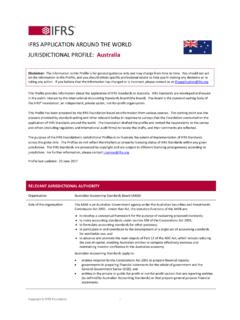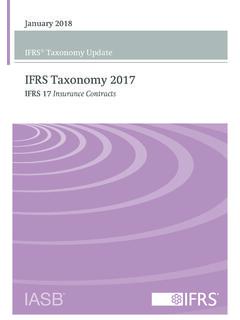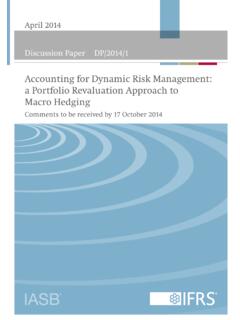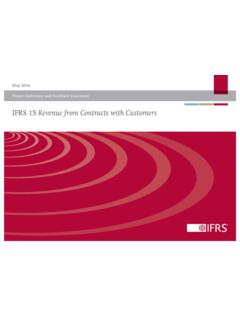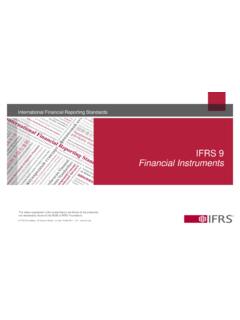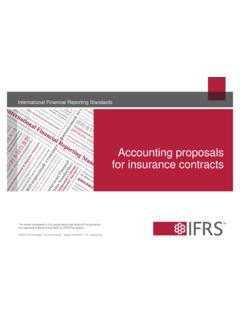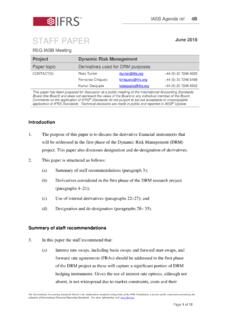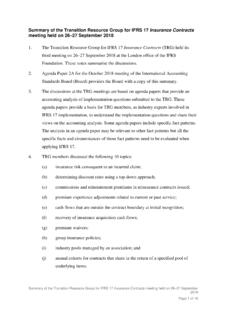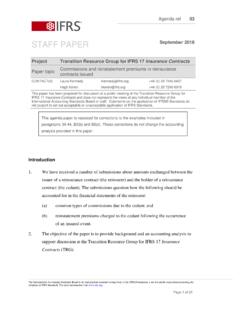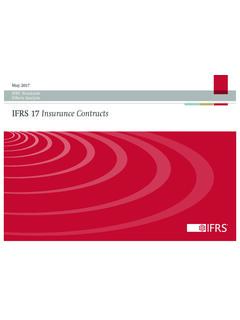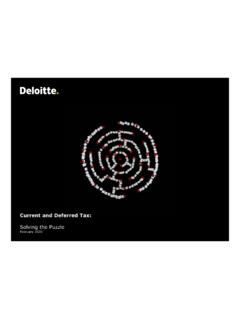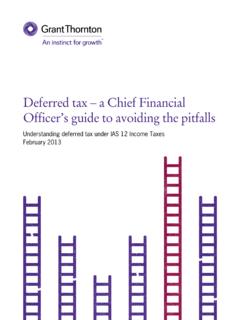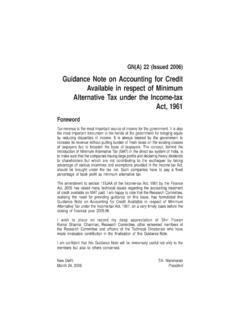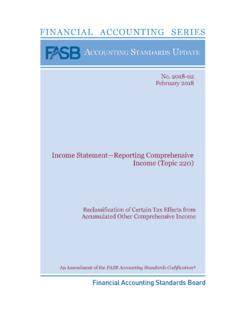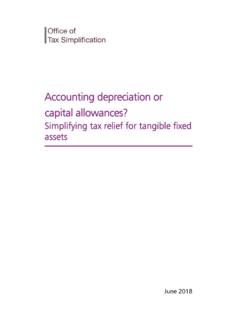Transcription of In Brief: Deferred Tax related to Assets and Liabilities ...
1 In brief: Deferred Tax related to Assets and Liabilities arising from a Single Transaction | July 2019 | 1In briefJuly 2019 Deferred Tax related to Assets and Liabilities arising from a Single Transaction Proposals to amend IAS 12 Income TaxesThe International accounting Standards Board (Board) proposes to amend IAS 12. The proposed amendments would clarify the accounting for Deferred tax on particular transactions, such as leases and decommissioning Kabureck, a member of the Board, explains what the Board is proposing and is Deferred tax? Deferred tax represents amounts of income tax payable or recoverable in the do companies report Deferred tax?A company recognises Deferred tax when recovering an asset or settling a liability in the future will have tax consequences (that is, will affect the amount of tax the company will pay).
2 Such tax consequences result from differences between the amount of Assets and Liabilities for accounting purposes (their carrying amount) and the amount for tax purposes (their tax base).1 These differences are known as temporary differences because they will eventually reverse when the company recovers the asset or settles the reversal of temporary differences will either increase or reduce taxable profit. A company recognises:(a) a Deferred tax asset for temporary differences that will reduce taxable profit (deductible temporary differences).(b) a Deferred tax liability for temporary differences that will increase taxable profit (taxable temporary differences).Example 1 illustrates these 1 Deferred tax asset related to a provisionApplying IAS 37 Provisions, Contingent Liabilities and Contingent Assets , a company recognises a provision of CU100 regarding a legal The company receives a deduction for tax purposes only when it makes payments to settle the legal dispute.
3 The company determines that the tax base of the provision is nil (carrying amount of CU100 less the amount that will be deductible for tax purposes, also CU100).There is a deductible temporary difference of CU100 between the carrying amount of the provision (CU100) and its tax base (nil). This deductible temporary difference will reverse when the company makes payments to settle the provision and receives the tax deductions. These tax deductions will reduce the company s taxable profit in future periods. Accordingly, the company recognises a Deferred tax The tax base of an asset is the amount that will be deductible for tax purposes; the tax base of a liability is its carrying amount, less any amounts that will be deductible for tax In this document, monetary units are denominated in currency units (CU).
4 In brief: Deferred Tax related to Assets and Liabilities arising from a Single Transaction | July 2019 | 2 How do these requirements apply to leases?IFRS 16 Leases requires a company to recognise a right-of-use asset (lease asset) and a lease liability for Over the lease term, the company recognises depreciation and interest expense as it uses the lease asset and settles the lease , many tax authorities provide tax deductions only when a company makes lease payments (not when a company recognises depreciation and interest expense). In these circumstances, a company needs to apply judgement in determining whether those tax deductions relate to the lease asset or to the lease liability.
5 Depending on the applicable tax law, tax deductions may relate to either:(a) the lease asset because they relate to expenses from the lease (depreciation and interest expense); or(b) the lease liability because they relate to the repayment of the lease liability and interest 1 illustrates these In this document, we use leases as an example, but the explanations apply equally to decommissioning obligations and any other transactions that give rise to both an asset and a tax deductions relate to the lease asset, no temporary differences arise when a company initially recognises the lease asset and lease liability. However, when tax deductions relate to the lease liability, temporary differences arise on initial recognition.
6 Diagram 2 illustrates these 2 Outcomes of allocating tax deductionsTa x deductions relate to: Lease assetTax bases = carrying amountsNo temporary differencesTemporary differencesariseTax bases = nil LeaseliabilityA company would recognise Deferred tax for such temporary differences applying the general principle in IAS 12. However, IAS 12 prohibits a company from doing so if the recognition exemption is the recognition exemption?The recognition exemption prohibits a company from recognising Deferred tax when it initially recognises an asset or liability in particular circumstances. One of these circumstances is the recognition of a transaction that affects neither accounting profit nor taxable profit (and is not a business combination).
7 Does the recognition exemption apply to leases?The Board is aware that views differ on whether the recognition exemption applies to temporary differences arising when a company initially recognises a lease. When the recognition exemption applies, a company does not recognise Deferred tax, either on initial recognition of the lease or subsequently throughout the lease 1 Allocating tax deductionsCompany determines if tax deductions relate to:Expenses from the leaseRepayment of the lease liabilityLease assetLease liabilityorIn brief: Deferred Tax related to Assets and Liabilities arising from a Single Transaction | July 2019 | 3 What are the consequences of not recognising Deferred tax?
8 When a company does not recognise Deferred tax, the tax expense for a period will reflect tax deductions as and when they become available for tax purposes (that is, when lease payments are made), rather than as the company uses the lease asset and settles the lease 2 illustrates the effects of recognising (or not recognising) Deferred tax on a 2 effects of recognising (or not recognising) Deferred tax on a leaseConsider the following simplified scenario: A company leases a building for five years and depreciates the lease asset on a straight-line basis over the five-year lease term. Lease payments of CU100 are payable at the end of each year and are deductible for tax purposes when paid.
9 The company recognises revenue of CU120 each year and has no other expenses. The discount rate applied to the lease is 5% and the company is subject to a tax rate of 20%.Graph 1 illustrates the outcome of recognising Deferred tax over the lease term. This would be the outcome when tax deductions relate to the lease asset. The graph shows that the tax expense recognised over time is proportional to profit before tax, resulting in a constant effective tax rate over the period. The company reflects the tax effects of the lease in profit or loss as it uses the lease asset and recognises interest on the lease 2 illustrates the outcome of not recognising Deferred tax. This would be the outcome when tax deductions relate to the lease liability and the recognition exemption applies.
10 The graph shows that the tax expense recognised is constant over time, resulting in different effective tax rates in each year. The company reflects the tax effects of the lease in profit or loss as the tax deductions become available for tax purposes (that is, when lease payments are made).(The appendix sets out the detailed calculations used in this example.)Profit before taxTax expenseEffective tax rate20%20%Year 4 Year 5 Graph 1 Recognising Deferred tax 51015202530 Year 120%20%20%Year 3 Year 2 Profit before taxTax expenseEffective tax rateGraph 2 Not recognising Deferred tax 51015202530 Year 136%25%20%17%14%Year 3 Year 2 Year 4 Year 5In brief: Deferred Tax related to Assets and Liabilities arising from a Single Transaction | July 2019 | 4 What is the Board proposing?
